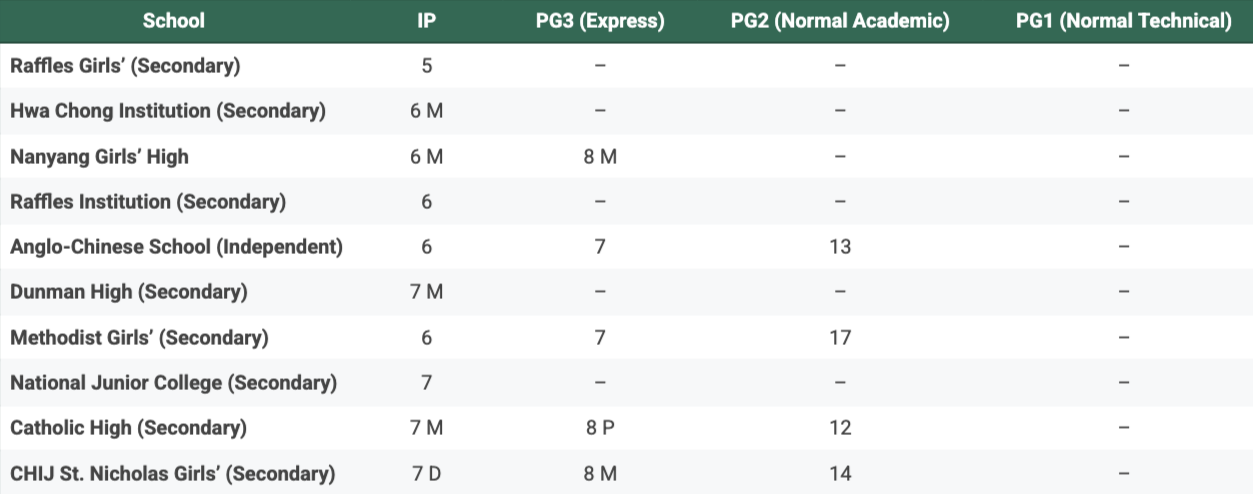PSLE Cut-Off Points 2025 — Full List & How They’re Calculated
Understanding your child’s PSLE cut-off point (COP) options is one of the most important parts of Secondary 1 posting.
With every new school year, cut-off points change slightly — and for 2025, parents are already searching for the latest information to guide their choices.
In this article, we’ll explain exactly what PSLE cut-off points are, how they’re calculated, and share a full list of 2025 school COPs to help you shortlist confidently.
Contents:
What Are PSLE Cut-Off Points? 📚
A PSLE cut-off point (COP) is the PSLE Score of the last student admitted into a particular school in the previous posting exercise.
In simple terms:
It shows you the minimum PSLE score required to enter that school in the last round of admissions.
Each year, COPs shift slightly based on the number of applicants, school demand, and overall student performance. The lower the COP, the more competitive the school.
Example: If a school’s 2024 COP for the Express stream was 5, it means the last student admitted scored an AL 5. For 2025, this could change depending on cohort trends.
How Are PSLE Cut-Off Points Calculated? 🏆
The Ministry of Education (MOE) determines COPs based on the new PSLE AL (8-subject) scoring system, not aggregate marks.
Here’s how it works:
Each subject is graded AL1 to AL8 (1 = best, 8 = lowest).
Total PSLE Score = sum of your child’s four subject ALs.
The best possible score is 4.
The highest is 32.
Schools admit students based on their PSLE Score until all places are filled.
The score of the last student admitted becomes the COP for that year.
Key implications for parents:
A COP is descriptive, not prescriptive—it describes last year’s admission threshold and changes every year.
It’s a guide, not a guarantee.
PSLE Cut-Off Points 2025 🗓️
Below is a list of the latest 2025 secondary school cut-off points (COPs) for the top 10 schools, showing the Express, Normal (Academic), and Normal (Technical) streams.
📘 Note: “M” = Higher Chinese Merit needed, “P” = Higher Chinese Pass.
Why Do COPs Change Year To Year? 📊
Cut-off points fluctuate because they’re demand-driven — schools don’t set them in advance.
They depend on:
Cohort performance: If the cohort performs better overall, COPs tighten (drop).
School demand: Highly sought-after schools often have lower COPs.
Programme structure: Integrated Programme (IP) or SAP schools usually have more selective COPs.
Affiliations & HCL results: Linked primary schools or Higher Chinese Language (HCL) performance can also influence outcomes.
The MOE uses this system to maintain fairness and ensure each child has a place that suits their academic level.
How To Use COPs When Shortlisting Schools 🏫
1) Build a balanced shortlist. Include a mix of:
Ambitious options (at or slightly below last year’s COP)
Realistic options (1–2 points above last year’s COP)
Safe options (3–4 points above last year’s COP)
2) Look beyond the number. Consider travel time, school culture, CCA fit, academic support, and your child’s interests.
3) Keep learning focused and consistent. Working steadily on English comprehension, writing, and language use often yields the biggest gains by exam season. Parents tell us that structured guidance helps children convert effort into actual marks.
Strengthen Your Child’s English Ahead of Posting ✏️
If your child would benefit from clear English teaching, exam-style practice, and targeted feedback, our small-group online tuition is designed to build confidence and exam technique across Papers 1 and 2.
Summary 🔁
Treat the 2025 COP list as a helpful signal, not the full story. Build a balanced shortlist, keep preparation steady, and remember that the right environment is the one where your child feels supported to do their best.
If you’d like to talk through your child’s current English performance and a sensible school shortlist strategy, we’re here to help.


